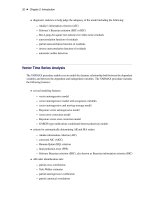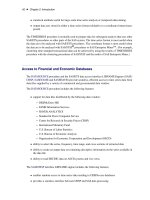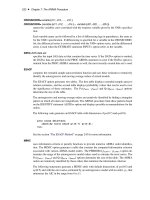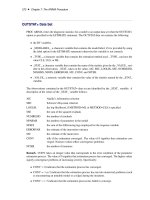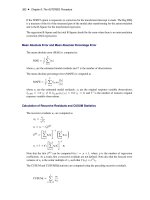SAS/ETS 9.22 User''''s Guide 74 pps
Bạn đang xem bản rút gọn của tài liệu. Xem và tải ngay bản đầy đủ của tài liệu tại đây (236.46 KB, 10 trang )
722 ✦ Chapter 12: The ENTROPY Procedure (Experimental)
References
Coleman, J. S., Campbell, E. Q., Hobson, C. J., McPartland, J., Mood, A. M., Weinfeld, F. D., and
York, R. L. (1966), Equality of Educational Opportunity, Washington, DC: U.S. Government
Printing Office.
Deaton, A. and Muellbauer, J. (1980), “An Almost Ideal Demand System,” The American Economic
Review, 70, 312–326.
Golan, A., Judge, G., and Miller, D. (1996), Maximum Entropy Econometrics: Robust Estimation
with Limited Data, Chichester, England: John Wiley & Sons.
Golan, A., Judge, G., and Perloff, J. (1996), “A Generalized Maximum Entropy Approach to
Recovering Information from Multinomial Response Data,” Journal of the American Statistical
Association, 91, 841–853.
Golan, A., Judge, G., and Perloff, J. (1997), “Estimation and Inference with Censored and Ordered
Multinomial Response Data,” Journal of Econometrics, 79, 23–51.
Golan, A., Judge, G., and Perloff, J. (2002), “Comparison of Maximum Entropy and Higher-Order
Entropy Estimators,” Journal of Econometrics, 107, 195–211.
Good, I. J. (1963), “Maximum Entropy for Hypothesis Formulation, Especially for Multidimensional
Contingency Tables,” Annals of Mathematical Statistics, 34, 911–934.
Harmon, A. M., Preckel, P., and Eales, J. (1998), Maximum Entropy-Based Seemingly Unrelated
Regression, Master’s thesis, Purdue University.
Jaynes, E. T. (1957), “Information of Theory and Statistical Mechanics,” Physics Review, 106,
620–630.
Jaynes, E. T. (1963), “Information Theory and Statistical Mechanics,” in K. W. Ford, ed., Brandeis
Lectures in Theoretical Physics, volume 3, Statistical Physics, 181–218, New York, Amsterdam:
W. A. Benjamin Inc.
Kapur, J. N. and Kesavan, H. K. (1992), Entropy Optimization Principles with Applications, Boston:
Academic Press.
Kullback, J. (1959), Information Theory and Statistics, New York: John Wiley & Sons.
Kullback, J. and Leibler, R. A. (1951), “On Information and Sufficiency,” Annals of Mathematical
Statistics.
LaMotte, L. R. (1994), “A Note on the Role of Independence in
t
Statistics Constructed from Linear
Statistics in Regression Models,” The American Statistician, 48, 238–240.
Miller, D., Eales, J., and Preckel, P. (2003), “Quasi-Maximum Likelihood Estimation with Bounded
Symmetric Errors,” in Advances in Econometrics, volume 17, 133–148, Elsevier.
Mittelhammer, R. C. and Cardell, S. (2000), “The Data-Constrained GME Estimator of the GLM:
Asymptotic Theory and Inference,” Working paper of the Department of Statistics, Washington
State University, Pullman.
References ✦ 723
Mittelhammer, R. C., Judge, G. G., and Miller, D. J. (2000), Econometric Foundations, Cambridge:
Cambridge University Press.
Myers, R. H. and Montgomery, D. C. (1995), Response Surface Methodology: Process and Product
Optimization Using Designed Experiments, New York: John Wiley & Sons.
Shannon, C. E. (1948), “A Mathematical Theory of Communication,” Bell System Technical Journal,
27, 379–423 and 623–656.
724
Chapter 13
The ESM Procedure
Contents
Overview: ESM Procedure . . . . . . . . . . . . . . . . . . . . . . . . . . . . . . 726
Getting Started: ESM Procedure . . . . . . . . . . . . . . . . . . . . . . . . . . . 726
Syntax: ESM Procedure . . . . . . . . . . . . . . . . . . . . . . . . . . . . . . . 728
Functional Summary . . . . . . . . . . . . . . . . . . . . . . . . . . . . . . 728
PROC ESM Statement . . . . . . . . . . . . . . . . . . . . . . . . . . . . . 730
BY Statement . . . . . . . . . . . . . . . . . . . . . . . . . . . . . . . . . 733
FORECAST Statement . . . . . . . . . . . . . . . . . . . . . . . . . . . . 733
ID Statement . . . . . . . . . . . . . . . . . . . . . . . . . . . . . . . . . . 735
Details: ESM Procedure . . . . . . . . . . . . . . . . . . . . . . . . . . . . . . . 738
Accumulation . . . . . . . . . . . . . . . . . . . . . . . . . . . . . . . . . 739
Missing Value Interpretation . . . . . . . . . . . . . . . . . . . . . . . . . . . 741
Transformations . . . . . . . . . . . . . . . . . . . . . . . . . . . . . . . . . 741
Parameter Estimation . . . . . . . . . . . . . . . . . . . . . . . . . . . . . . 741
Missing Value Modeling Issues . . . . . . . . . . . . . . . . . . . . . . . . . 741
Forecasting . . . . . . . . . . . . . . . . . . . . . . . . . . . . . . . . . . . 742
Inverse Transformations . . . . . . . . . . . . . . . . . . . . . . . . . . . . 742
Statistics of Fit . . . . . . . . . . . . . . . . . . . . . . . . . . . . . . . . . 742
Forecast Summation . . . . . . . . . . . . . . . . . . . . . . . . . . . . . . 742
Data Set Output . . . . . . . . . . . . . . . . . . . . . . . . . . . . . . . . 743
Printed Output . . . . . . . . . . . . . . . . . . . . . . . . . . . . . . . . . 748
ODS Table Names . . . . . . . . . . . . . . . . . . . . . . . . . . . . . . . 748
ODS Graphics . . . . . . . . . . . . . . . . . . . . . . . . . . . . . . . . . 749
Examples: ESM Procedure . . . . . . . . . . . . . . . . . . . . . . . . . . . . . . 750
Example 13.1: Forecasting of Time Series Data . . . . . . . . . . . . . . . 750
Example 13.2: Forecasting of Transactional Data . . . . . . . . . . . . . . 753
Example 13.3: Specifying the Forecasting Model . . . . . . . . . . . . . . 755
Example 13.4: Extending the Independent Variables for Multivariate Forecasts 755
Example 13.5: Illustration of ODS Graphics . . . . . . . . . . . . . . . . . . 757
726 ✦ Chapter 13: The ESM Procedure
Overview: ESM Procedure
The ESM procedure generates forecasts by using exponential smoothing models with optimized
smoothing weights for many time series or transactional data.
For typical time series, you can use the following smoothing models:
– simple
– double
– linear
– damped trend
– seasonal
– Winters method (additive and multiplicative)
Additionally, transformed versions of these models are provided:
– log
– square root
– logistic
– Box-Cox
Graphics are available with the ESM procedure. For more information, see the section “ODS
Graphics” on page 749.
The exponential smoothing models supported in PROC ESM differ from those supported in PROC
FORECAST since all parameters associated with the forecasting model are optimized by PROC
ESM based on the data.
The ESM procedure writes the time series extrapolated by the forecasts, the series summary statistics,
the forecasts and confidence limits, the parameter estimates, and the fit statistics to output data sets.
The ESM procedure optionally produces printed output for these results by using the Output Delivery
System (ODS).
The ESM procedure can forecast both time series data, whose observations are equally spaced by a
specific time interval (for example, monthly, weekly), or transactional data, whose observations are
not spaced with respect to any particular time interval. Internet, inventory, sales, and similar data are
typical examples of transactional data. For transactional data, the data are accumulated based on a
specified time interval to form a time series prior to modeling and forecasting.
Getting Started: ESM Procedure
The ESM procedure is simple to use and does not require in-depth knowledge of forecasting methods.
It can provide results in output data sets or in other output formats by using the Output Delivery
Getting Started: ESM Procedure ✦ 727
System (ODS). The following examples are more fully illustrated in “Example 13.2: Forecasting of
Transactional Data” on page 753.
Given an input data set that contains numerous time series variables recorded at a specific frequency,
the ESM procedure can forecast the series as follows:
proc esm data=<input-data-set> out=<output-data-set>;
id <time-ID-variable> interval=<frequency>;
forecast <time-series-variables>;
run;
For example, suppose that the input data set SALES contains sales data recorded monthly, the variable
that represents time is DATE, and the forecasts are to be recorded in the output data set
NEXTYEAR
.
The ESM procedure could be used as follows:
proc esm data=sales out=nextyear;
id date interval=month;
forecast _numeric_;
run;
The preceding statements generate forecasts for every numeric variable in the input data set SALES
for the next twelve months and store these forecasts in the output data set NEXTYEAR. Other output
data sets can be specified to store the parameter estimates, forecasts, statistics of fit, and summary
data.
By default, PROC ESM generates no printed output. If you want to print the forecasts by using the
Output Delivery System (ODS), then you need to add the PRINT=FORECASTS option to the PROC
ESM statement, as shown in the following example:
proc esm data=sales out=nextyear print=forecasts;
id date interval=month;
forecast _numeric_;
run;
Other PRINT= options can be specified to print the parameter estimates, statistics of fit, and summary
data.
The ESM procedure can forecast both time series data, whose observations are equally spaced by a
specific time interval (for example, monthly, weekly), or transactional data, whose observations are
not spaced with respect to any particular time interval.
Given an input data set that contains transactional variables not recorded at any specific frequency,
the ESM procedure accumulates the data to a specific time interval and forecasts the accumulated
series as follows:
proc esm data=<input-data-set> out=<output-data-set>;
id <time-ID-variable> interval=<frequency>
accumulate=<accumulation>;
forecast <time-series-variables> / model=<esm>;
run;
728 ✦ Chapter 13: The ESM Procedure
For example, suppose that the input data set WEBSITES contains three variables (BOATS, CARS,
PLANES) that are Internet data recorded on no particular time interval, and the variable that represents
time is TIME, which records the time of the Web hit. The forecasts for the total daily values are to
be recorded in the output data set NEXTWEEK. The ESM procedure could be used as follows:
proc esm data=websites out=nextweek lead=7;
id time interval=dtday accumulate=total;
forecast boats cars planes;
run;
The preceding statements accumulate the data into a daily time series, generate forecasts for the
BOATS, CARS, and PLANES variables in the input data set (WEBSITES) for the next seven days, and
store the forecasts in the output data set (NEXTWEEK). Because the MODEL= option is not specified
in the FORECAST statement, a simple exponential smoothing model is fit to each series.
Syntax: ESM Procedure
The following statements are used with the ESM procedure:
PROC ESM options ;
BY variables ;
ID variable INTERVAL= interval options ;
FORECAST variable-list / options ;
Functional Summary
The statements and options that control the ESM procedure are summarized in the following table.
Table 13.1 Syntax Summary
Description Statement Option
Statements
specify data sets and options PROC ESM
specify BY-group processing BY
specify variables to forecast FORECAST
specify the time ID variable ID
Data Set Options
specify the input data set PROC ESM DATA=
specify to output forecasts only PROC ESM NOOUTALL
specify the output data set PROC ESM OUT=
specify parameter output data set PROC ESM OUTEST=
Functional Summary ✦ 729
Description Statement Option
specify forecast output data set PROC ESM OUTFOR=
specify the forecast procedure information out-
put data set
PROC ESM OUTPROCINFO=
specify statistics output data set PROC ESM OUTSTAT=
specify summary output data set PROC ESM OUTSUM=
replace actual values held back FORECAST REPLACEBACK
replace missing values FORECAST REPLACEMISSING
use forecast value to append FORECAST USE=
Accumulation and Seasonality Options
specify accumulation frequency ID INTERVAL=
specify length of seasonal cycle PROC ESM SEASONALITY=
specify interval alignment ID ALIGN=
specify that time ID variable values are not
sorted
ID NOTSORTED
specify starting time ID value ID START=
specify ending time ID value ID END=
specify accumulation statistic ID, FORECAST ACCUMULATE=
specify missing value interpretation ID, FORECAST SETMISSING=
specify zero value interpretation ID, FORECAST ZEROMISS=
Forecasting Horizon, Holdback Options
specify data to hold back PROC ESM BACK=
specify forecast horizon or lead PROC ESM LEAD=
specify horizon to start summation PROC ESM STARTSUM=
Forecasting Model Options
specify confidence limit width FORECAST ALPHA=
specify forecast model FORECAST MODEL=
specify median forecats FORECAST MEDIAN
specify backcast initialization FORECAST NBACKCAST=
specify model transformation FORECAST TRANSFORM=
Printing and Plotting Control Options
specify time ID format ID FORMAT=
specify graphical output PROC ESM PLOT=
specify printed output PROC ESM PRINT=
specify detailed printed output PROC ESM PRINTDETAILS
Miscellaneous Options
specify that analysis variables are processed in
sorted order
PROC ESM SORTNAMES
limit error and warning messages PROC ESM MAXERROR=
730 ✦ Chapter 13: The ESM Procedure
PROC ESM Statement
PROC ESM options ;
The following options can be used in the PROC ESM statement.
BACK=n
specifies the number of observations before the end of the data where the multistep forecasts
are to begin. The default is BACK=0.
DATA=SAS-data-set
names the SAS data set that contains the input data for the procedure to forecast. If the DATA=
option is not specified, the most recently created SAS data set is used.
LEAD=n
specifies the number of periods ahead to forecast (forecast lead or horizon). The default is
LEAD=12.
The LEAD= value is relative to the BACK= option specification and to the last observation in
the input data set or the accumulated series, and not to the last nonmissing observation of a
particular series. Thus, if a series has missing values at the end, the actual number of forecasts
computed for that series is greater than the LEAD= value.
MAXERROR=number
limits the number of warning and error messages produced during the execution of the
procedure to the specified value. The default is MAXERRORS=50. This option is particularly
useful in BY-group processing where it can be used to suppress the recurring messages.
NOOUTALL
specifies that only forecasts are written to the OUT= and OUTFOR= data sets. The
NOOUTALL option includes only the final forecast observations in the output data sets;
it does not include the one-step forecasts for the data before the forecast period.
The OUT= and OUTFOR= data set will only contain the forecast results starting at the next
period following the last observation and ending with the forecast horizon specified by the
LEAD= option.
OUT=SAS-data-set
names the output data set to contain the forecasts of the variables specified in the subsequent
FORECAST statements. If an ID variable is specified, it is also included in the OUT= data
set. The values are accumulated based on the ACCUMULATE= option, and forecasts are
appended to these values based on the FORECAST statement USE= option. The OUT= data
set is particularly useful in extending the independent variables. The OUT= data set can be
used as the input data set in a subsequent PROC step to forecast a dependent series by using a
regression modeling procedure. If the OUT= option is not specified, a default output data set
is created by using the DATAn convention. If you do not want the OUT= data set created, use
OUT=_NULL_.
PROC ESM Statement ✦ 731
OUTEST=SAS-data-set
names the output data set to contain the model parameter estimates and the associated test
statistics and probability values. The OUTEST= data set is useful for evaluating the significance
of the model parameters and understanding the model dynamics.
OUTFOR=SAS-data-set
names the output data set to contain the forecast time series components (actual, predicted,
lower confidence limit, upper confidence limit, prediction error, prediction standard error).
The OUTFOR= data set is useful for displaying the forecasts in tabular or graphical form.
OUTPROCINFO=SAS-data-set
names the output data set to contain information in the SAS log, specifically the number
of notes, errors, and warnings and the number of series processed, forecasts requested, and
forecasts failed.
OUTSTAT=SAS-data-set
names the output data set to contain the statistics of fit (or goodness-of-fit statistics). The
OUTSTAT= data set is useful for evaluating how well the model fits the series.
OUTSUM=SAS-data-set
names the output data set to contain the summary statistics and the forecast summation. The
summary statistics are based on the accumulated time series when the ACCUMULATE= or
SETMISSING= options are specified. The forecast summations are based on the LEAD=,
STARTSUM=, and USE= options. The OUTSUM= data set is useful when forecasting large
numbers of series and a summary of the results are needed.
PLOT=option | ( options )
specifies the graphical output desired. By default, the ESM procedure produces no graphical
output. The following plotting options are available:
ERRORS plots prediction error time series graphics.
ACF plots prediction error autocorrelation function graphics.
PACF plots prediction error partial autocorrelation function graphics.
IACF plots prediction error inverse autocorrelation function graphics.
WN plots white noise graphics.
MODELS plots model graphics.
FORECASTS plots forecast graphics.
MODELFORECASTSONLY
plots forecast graphics with confidence limits in the data
range.
FORECASTSONLY plots the forecast in the forecast horizon only.
LEVELS plots smoothed level component graphics.
SEASONS plots smoothed seasonal component graphics.
TRENDS plots smoothed trend (slope) component graphics.
ALL is the same as specifying all of the above PLOT= options.
